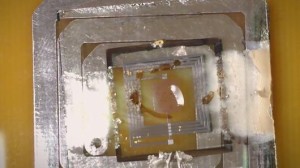Expanding on previous research into electronic devices that dissolve in water once they have reached the end of their useful life, researchers at the University of Illinois have developed a new type of “transient” electronic device that self-destructs in response to heat exposure. The work is aimed at making it easy for materials from devices that usually end up in landfill to be recycled or dissolved completely.
The research involved a group led by aerospace engineering professor Scott R. White teaming up with John A. Rogers, who previously led work in the development of transient electronics that biodegrade in water. These previous devices dissolved in water after a predetermined period of time, which was related to the thickness of outer protective layers encapsulating the actual electronics. But using heat as a trigger has now enabled the creation of electronic devices that can be prompted to self-destruct on demand.
The technology involves first printing magnesium circuits on thin, flexible materials. Microscopic droplets of a weak acid are then trapped in wax, which is coated onto the devices. When exposed to heat, the wax melts and releases the acid, which completely dissolves the device. The researchers were also able to create devices that can be remotely triggered to self-destruct by embedding a radio-frequency receiver and inductive heating coil. In response to a radio signal, the coil heats up and melts the wax, leading to the destruction of the device.
For More Details: Things heat up for self-destructing electronic devices

